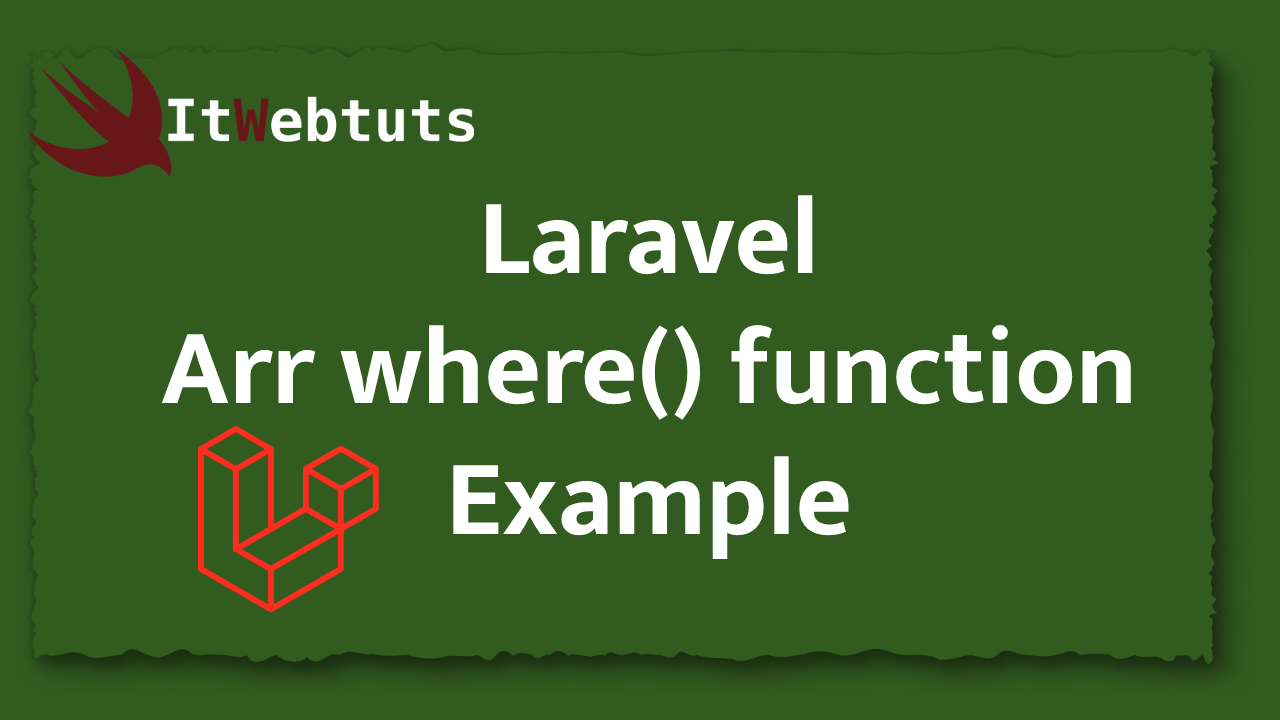Hey Dev,
Today, I would really like to percentage with you how to generate slug in laravel livewire .i will display you a complete instance for generate slug example with laravel livewire. we will talk approximately a way to create Livewire slug in laravel.
Livewire is a full-stack framework for Laravel that makes building dynamic interfaces easy, with out leaving the comfort of Laravel.Livewire is based entirely on AJAX requests to do all its server communicaton. right here i can provide complete example for laravel livewire generate slug example,So we could follow the bellow step.
Step 1 : Install Laravel AppIn First step, We need to get fresh laravel version application using bellow command. So Let's open terminal and run bellow command.
composer create-project --prefer-dist laravel/laravel blogStep 2 : Setup Database Configuration
After successfully install laravel app thenafter configure databse setup. We will open ".env" file and change the database name, username and password in the env file.
DB_CONNECTION=mysql DB_HOST=127.0.0.1 DB_PORT=3306 DB_DATABASE=Enter_Your_Database_Name DB_USERNAME=Enter_Your_Database_Username DB_PASSWORD=Enter_Your_Database_PasswordStep 3 : Install Livewire
In this step, You will simply install livewire to our laravel application using bellow command:
composer require livewire/livewireStep 4 : Install "cviebrock/eloquent-sluggable" Package
In this step, You will simply install "cviebrock/eloquent-sluggable" for generate slug to our laravel application using bellow command:
composer require cviebrock/eloquent-sluggable
The package will automatically register its service provider.publish the configuration file if you want to change any defaults using bellow command:
php artisan vendor:publish --provider="Cviebrock\EloquentSluggable\ServiceProvider"
Your models should use the Sluggable trait, which has an abstract method sluggable() that you need to define. This is where any model-specific configuration is set (see Configuration below for details):
use Cviebrock\EloquentSluggable\Sluggable;
class Post extends Model
{
use Sluggable;
/**
* Return the sluggable configuration array for this model.
*
* @return array
*/
public function sluggable(): array
{
return [
'slug' => [
'source' => 'title'
]
];
}
}
Step 5 : Create Post Table
In this step, We have to create migration for blogs table using bellow artisan command. So let's open terminal and run bello command :
php artisan make:model Post -mdatabase/migrations/2021_06_05_044246_create_posts_table.php
<?php
use Illuminate\Database\Migrations\Migration;
use Illuminate\Database\Schema\Blueprint;
use Illuminate\Support\Facades\Schema;
class CreatePostsTable extends Migration
{
/**
* Run the migrations.
*
* @return void
*/
public function up()
{
Schema::create('posts', function (Blueprint $table) {
$table->id();
$table->string('title');
$table->string('slug');
$table->timestamps();
});
}
/**
* Reverse the migrations.
*
* @return void
*/
public function down()
{
Schema::dropIfExists('posts');
}
}
App/Models/Post.php
<?php
namespace App\Models;
use Illuminate\Database\Eloquent\Factories\HasFactory;
use Illuminate\Database\Eloquent\Model;
use Cviebrock\EloquentSluggable\Sluggable;
class Post extends Model
{
use HasFactory,Sluggable;
protected $fillable = [
'title','slug'
];
/**
* Return the sluggable configuration array for this model.
*
* @return array
*/
public function sluggable(): array
{
return [
'slug' => [
'source' => 'title'
]
];
}
}
Step 6 : Create Component
Now, You can create livewire component using bellow command, So Let's run bellow command to create Posts form component:
php artisan make:livewire Posts
Now they created fies on both path:
app/Http/Livewire/Posts.php resources/views/livewire/posts.blade.php
Now first file we will update as bellow for Posts.php file.
app/Http/Livewire/Posts.php
<?php
namespace App\Http\Livewire;
use Livewire\Component;
use \Cviebrock\EloquentSluggable\Services\SlugService;
use App\Models\Post;
class Posts extends Component
{
public $title;
public $slug;
public function render()
{
$posts = Post::latest()->take(5)->get();
return view('livewire.posts', compact('posts'));
}
public function updatedTitle()
{
$this->slug = SlugService::createSlug(Post::class, 'slug', $this->title);
}
public function store()
{
Post::create([
'title' => $this->title,
'slug' => $this->slug
]);
$this->title = '';
$this->slug = '';
}
}
Step 7 : Add Route
In this step, we need to add route for Show posts and create post in laravel application. so open your "routes/web.php" file and add following route.
routes/web.php
Route::view('posts','livewire.home');
Step 8 : Create View
Here, we will create blade file for call modal route. in this file we will use @livewireStyles, @livewireScripts and @livewire('posts'). so let's add it.
resources/views/livewire/home.blade.php
<!DOCTYPE html>
<html>
<head>
<title></title>
<script src="{{ asset('js/app.js') }}" defer></script>
<link href="{{ asset('css/app.css') }}" rel="stylesheet">
<link rel="stylesheet" href="https://cdnjs.cloudflare.com/ajax/libs/font-awesome/5.15.3/css/all.min.css" integrity="sha512-iBBXm8fW90+nuLcSKlbmrPcLa0OT92xO1BIsZ+ywDWZCvqsWgccV3gFoRBv0z+8dLJgyAHIhR35VZc2oM/gI1w==" crossorigin="anonymous" referrerpolicy="no-referrer" />
<script src="https://cdnjs.cloudflare.com/ajax/libs/twitter-bootstrap/4.6.0/js/bootstrap.min.js" integrity="sha512-XKa9Hemdy1Ui3KSGgJdgMyYlUg1gM+QhL6cnlyTe2qzMCYm4nAZ1PsVerQzTTXzonUR+dmswHqgJPuwCq1MaAg==" crossorigin="anonymous" referrerpolicy="no-referrer"></script>
<link rel="stylesheet" href="https://cdnjs.cloudflare.com/ajax/libs/twitter-bootstrap/4.6.0/css/bootstrap.min.css" integrity="sha512-P5MgMn1jBN01asBgU0z60Qk4QxiXo86+wlFahKrsQf37c9cro517WzVSPPV1tDKzhku2iJ2FVgL67wG03SGnNA==" crossorigin="anonymous" referrerpolicy="no-referrer" />
@livewireStyles
</head>
<body class="bg-dark">
<div class="container mt-5">
<div class="row justify-content-center mt-5">
<div class="col-md-8 mt-5">
<div class="card">
<div class="card-header">
<h4>Laravel Livewire Slug Example</h4>
</div>
<div class="card-body">
@if (session()->has('message'))
<div class="alert alert-success">
{{ session('message') }}
</div>
@endif
@livewire('posts')
</div>
</div>
</div>
</div>
</div>
@livewireScripts
</body>
</html>
resources/views/livewire/posts.blade.php
<div>
<form wire:submit.prevent="store">
<div class="form-group row">
<label for="title" class="col-md-2 col-form-label text-md-right">Title</label>
<div class="col-md-6">
<input wire:model="title"
type="text"
class="form-control @error('title') is-invalid @enderror"
autofocus>
@error('title')
<span class="invalid-feedback" role="alert">
<strong>{{ $message }}</strong>
</span>
@enderror
</div>
</div>
<div class="form-group row">
<label for="slug" class="col-md-2 col-form-label text-md-right">Slug</label>
<div class="col-md-6">
<input wire:model="slug"
type="text"
class="form-control @error('slug') is-invalid @enderror">
@error('slug')
<span class="invalid-feedback" role="alert">
<strong>{{ $message }}</strong>
</span>
@enderror
</div>
</div>
<div class="form-group row mb-0">
<div class="col-md-8 offset-md-4">
<button type="submit" class="btn btn-primary">
Add Post
</button>
</div>
</div>
</form>
<table class="table table-bordered mt-2">
<thead>
<tr>
<th>Name</th>
<th>Slug</th>
</tr>
</thead>
<tbody>
@if($posts->count())
@foreach ($posts as $post)
<tr>
<td>{{ $post->title }}</td>
<td>{{ $post->slug }}</td>
</tr>
@endforeach
@endif
</tbody>
</table>
</div>
Now we are ready to run our example so run bellow command for quick run:
php artisan serve
Now you can open bellow URL on your browser:
http://localhost:8000/posts
It will help you..





















